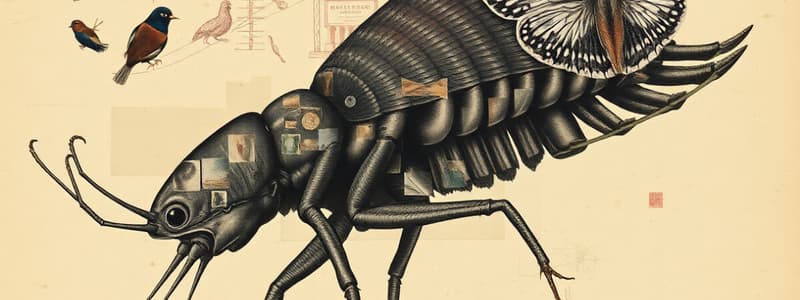Podcast
Questions and Answers
What is a characteristic feature of Porifera?
What is a characteristic feature of Porifera?
- Possess specialized cells called cnidocytes.
- Lack true tissues and organs. (correct)
- Have a closed circulatory system.
- Bilaterally symmetrical body structure.
Which group of invertebrates is known for having an exoskeleton made of chitin?
Which group of invertebrates is known for having an exoskeleton made of chitin?
- Platyhelminthes
- Annelida
- Arthropoda (correct)
- Mollusca
What ecological role do invertebrates commonly fulfill?
What ecological role do invertebrates commonly fulfill?
- Decomposers (correct)
- Primary producers
- Autotrophs
- Carnivores
Which group of invertebrates exhibits radial symmetry?
Which group of invertebrates exhibits radial symmetry?
What type of circulatory system do Annelida possess?
What type of circulatory system do Annelida possess?
Which mode of reproduction is NOT commonly found in invertebrates?
Which mode of reproduction is NOT commonly found in invertebrates?
Which adaptation helps invertebrates evade predators?
Which adaptation helps invertebrates evade predators?
Which of the following is a major threat to invertebrate populations?
Which of the following is a major threat to invertebrate populations?
Flashcards are hidden until you start studying
Study Notes
Overview
- Invertebrates are animals without a backbone.
- They make up approximately 97% of all animal species.
- Diverse habitats: terrestrial, freshwater, and marine environments.
Major Groups of Invertebrates
-
Porifera (Sponges)
- Simplest organisms, porous body.
- Lack true tissues and organs.
- Filter feeders.
-
Cnidaria
- Includes jellyfish, corals, and sea anemones.
- Possess specialized cells called cnidocytes for stinging.
- Exhibit radial symmetry.
-
Platyhelminthes (Flatworms)
- Bilateral symmetry, flat body structure.
- Includes free-living and parasitic species (e.g., tapeworms).
- Lack a circulatory or respiratory system.
-
Nematoda (Roundworms)
- Cylindrical body, covered by a tough exoskeleton.
- Many are parasitic; some are important decomposers.
- Well-developed digestive system.
-
Annelida (Segmented Worms)
- Segmented body plan, with specialized segments for different functions.
- Includes earthworms and leeches.
- Closed circulatory system.
-
Mollusca
- Soft-bodied, often with a protective shell.
- Major classes include Gastropoda (snails), Bivalvia (clams), and Cephalopoda (octopuses).
- Advanced nervous systems in cephalopods.
-
Arthropoda
- Largest phylum, including insects, arachnids, crustaceans.
- Exoskeleton made of chitin, segmented bodies, jointed appendages.
- Highly diverse - adapted to numerous ecological niches.
Importance of Invertebrates
- Ecological roles: Pollinators, decomposers, and prey for other animals.
- Economic significance: Source of food (e.g., shellfish) and products (e.g., silk, honey).
- Biodiversity indicators: Sensitive to environmental changes, important for ecosystem health.
Reproduction
- Modes of reproduction vary widely: asexual (budding, fission) and sexual reproduction.
- Some groups exhibit complex life cycles with larval stages.
Adaptations
- Invertebrates show incredible adaptations for survival:
- Camouflage for predator evasion.
- Bioluminescence in deep-sea species.
- Specialized feeding mechanisms (e.g., siphons in mollusks).
Threats and Conservation
- Habitat loss, pollution, climate change, and overfishing threaten invertebrate populations.
- Conservation efforts focus on habitat protection and sustainable practices.
Invertebrate Overview
- Invertebrates are animals without a backbone.
- They represent approximately 97% of all animal species.
- Inhabit diverse locations, including terrestrial, freshwater, and marine environments.
Major Invertebrate Groups
- Porifera (Sponges): The simplest animals, characterized by a porous body. They lack true tissues and organs and are filter feeders.
- Cnidaria: Includes jellyfish, corals, and sea anemones. They have specialized stinging cells called cnidocytes and exhibit radial symmetry.
- Platyhelminthes (Flatworms): Have bilateral symmetry and a flat body structure. Some are free-living, while others are parasitic (e.g., tapeworms). They lack a circulatory or respiratory system.
- Nematoda (Roundworms): Possess a cylindrical body covered by a tough exoskeleton. Many are parasitic, but some are important decomposers. They have a well-developed digestive system.
- Annelida (Segmented Worms): Exhibit a segmented body plan with specialized segments for different functions. Earthworms and leeches are examples. They have a closed circulatory system.
- Mollusca: Characterized by soft bodies, often with a protective shell. Major classes include gastropods (snails), bivalves (clams), and cephalopods (octopuses). Cephalopods have advanced nervous systems.
- Arthropoda: The largest phylum, including insects, arachnids, and crustaceans. They possess an exoskeleton made of chitin, segmented bodies, and jointed appendages. They are highly diverse and adapted to numerous ecological niches.
Importance of Invertebrates
- Play essential ecological roles:
- Pollinators
- Decomposers
- Prey for other animals
- Have economic significance:
- Source of food (e.g., shellfish)
- Source of products (e.g., silk, honey)
- Serve as biodiversity indicators:
- Sensitive to environmental changes
- Important for ecosystem health
Reproduction
- Various modes of reproduction:
- Asexual reproduction (budding, fission)
- Sexual reproduction
- Some groups exhibit complex life cycles with larval stages.
Adaptations
- Invertebrates showcase incredible adaptations for survival:
- Camouflage for predator evasion
- Bioluminescence in deep-sea species
- Specialized feeding mechanisms (e.g., siphons in mollusks)
Threats and Conservation
- Invertebrate populations face threats from:
- Habitat loss
- Pollution
- Climate change
- Overfishing
- Conservation efforts focus on:
- Habitat protection
- Sustainable practices
Studying That Suits You
Use AI to generate personalized quizzes and flashcards to suit your learning preferences.




